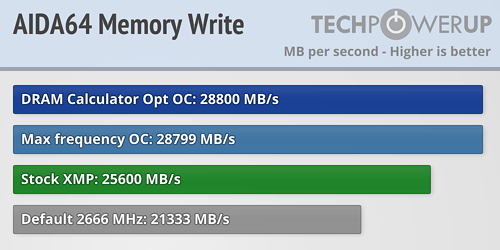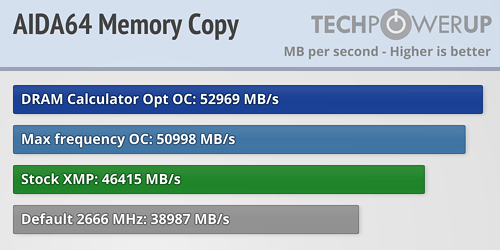 33
33
Crucial Ballistix Gaming Memory DDR4-3200 MHz CL16 4x16 GB Review
Value & Conclusion »Pushing For Speed
With testing out of the way, I endeavored to see if these sticks have any headroom. For Intel, I kept the same procedure I have been using, leaving all settings at their XMP defaults and then increasing the frequency until the system loses stability.While my two kits had no stability issues at their XMP speeds, I opted to do my overclocking in a two stick configuration. This is a closer comparison to the other kits I test.
I was able to get 3733 MHz out of this kit with all other XMP settings at their default. Like many recent kits, pushing past that proved difficult. Raising voltages did not yield better results (highest tested: DRAM: 1.5 V, VCCSA: 1.35 V, and VCCIO: 1.3 V).
For AMD overclocking, I wanted to dig a little deeper. First, I followed the same procedure as with Intel to find the maximum-possible frequency with XMP timings. Next, I set the frequency to 3600 MHz and used DRAM Calculator for Ryzen to optimize the timings. If the "Fast" preset was not viable, start with the "safe" settings and try to at least get the primary timings as close to the "Fast" preset as possible. I then benched each setting with AIDA64 to showcase what kind of benefits you can expect from each. I also included the default (non-XMP) settings as a base reference point.
I was able to squeeze 3800 MHz out of the Crucial Ballistix Gaming Memory on my MEG X570 ACE with the XMP default timings. For timings, the "Fast" preset booted perfectly at 3600 MHz! Considering this is a 400 MHz overclock, and some significant timing changes, that's a very impressive result!




It should be no surprise that boosting clock speed and tightening timings results in some noticeable gains.
May 3rd, 2025 09:12 EDT
change timezone
Latest GPU Drivers
New Forum Posts
- Gigabyte Gaming OC RTX4080 thermal pads (3)
- Ryzen 9 9950x3D (6)
- Are the 8 GB cards worth it? (709)
- AMD RX 7000 series GPU Owners' Club (1322)
- .exe to set default Browser (Firefox) w/o editing the Registry? (0)
- Graphics card holders are a disaster waiting to happen (11)
- Post your Speedometer 3.0 Score (117)
- Share your AIDA 64 cache and memory benchmark here (3064)
- 5060 Ti 8GB DOA (307)
- 5070 Ti power limit questions (76)
Popular Reviews
- Clair Obscur: Expedition 33 Performance Benchmark Review - 33 GPUs Tested
- ASUS Radeon RX 9070 XT TUF OC Review
- ASUS GeForce RTX 5090 Astral Liquid OC Review - The Most Expensive GPU I've Ever Tested
- ASUS ROG Maximus Z890 Hero Review
- Seasonic Vertex GX 850 W Review
- NVIDIA GeForce RTX 5060 Ti 8 GB Review - So Many Compromises
- Montech HS02 PRO Review
- Upcoming Hardware Launches 2025 (Updated Apr 2025)
- Oblivion Remastered Handheld Performance Review
- Sapphire Radeon RX 9070 XT Nitro+ Review - Beating NVIDIA
Controversial News Posts
- NVIDIA GeForce RTX 5060 Ti 16 GB SKU Likely Launching at $499, According to Supply Chain Leak (182)
- NVIDIA Sends MSRP Numbers to Partners: GeForce RTX 5060 Ti 8 GB at $379, RTX 5060 Ti 16 GB at $429 (128)
- AMD Radeon RX 9060 XT to Roll Out 8 GB GDDR6 Edition, Despite Rumors (116)
- NVIDIA Launches GeForce RTX 5060 Series, Beginning with RTX 5060 Ti This Week (115)
- Nintendo Confirms That Switch 2 Joy-Cons Will Not Utilize Hall Effect Stick Technology (105)
- NVIDIA PhysX and Flow Made Fully Open-Source (95)
- Sony Increases the PS5 Pricing in EMEA and ANZ by Around 25 Percent (84)
- Parts of NVIDIA GeForce RTX 50 Series GPU PCB Reach Over 100°C: Report (78)




